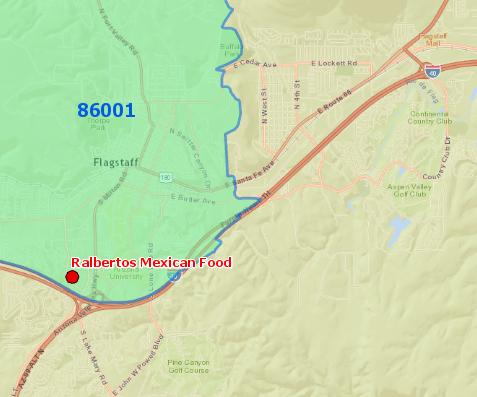
Nonetheless, sometimes I feel the urge to contribute reviews for those restaurants with which I'm still familiar, as well as to check out reviews by others. Perhaps I might even feel inclined to look at reviews for a place which I'm considering to visit.
While I acknowledge the existence of many crowd-sourced review sites, for this particular study I decided to focus on Yelp as an example of how such sites can go wrong.
Yelp claims to use "automated software" that filters and sorts reviews "based primarily on quality, reliability and the reviewer’s activity on Yelp", thereby supposedly relieving the intrepid seeker of recommendations from having to sort through the weeds to find useful reviews. The more I tried to determine the difference between approved and unapproved reviews, however, the more I was mystified by their methodology. I finally decided that the Yelp Sort was smoke and mirrors, and the filtering algorithm was pure snake oil. Clearly, there is a need for greater transparency when it comes to review analytics.
That's when I got the idea for a new type of restaurant review app: why not give the user the ability to sort through all submitted reviews and perform their own data filtering, analysis, and mapping? A well-designed and well-presented database, coupled with intuitive, simple-to-use tools, could conceivably allow the user to make queries and see the results in the form of map layers and charts.
Here are some examples of queries that might be made [see Appendix B for example results]:
I'm not proposing body cams for bathroom cleanliness, nor interruption of phone displays and earpieces for AI-driven contextual interrogation. That sort of approach cannot possibly work because it would be annoying. What is required is an interface that is completely voluntary and fun for people to use.
I'll leave the rest to your virtual-reality-embracing, geoboundary-driven, incessantly game-playing imagination.
In the meantime, let me use this as an introduction to a new feature in my own web site: ffred's restaurant reviews! No, it's not the aforementioned app, but at least it's a place where I can write about various restaurants any way I damn well want to.
RESTAURANTS
This feature class contains the geographic location as well as certain business data. It would be maintained in the back-office, perhaps via wiki.
GLOBALID: A unique identifier.
NAME: Three guesses, and the first two don't count.
HOURS: I could not think of a good way to model this in a single field. Instead, I created a joined table. Hence, the need for a unique identifier.
BUSINESS CATEGORY: This was the toughest measure for me to decide. I definitely prefer local establishments to large chains, but there are gradations in between. Finally, I settled on the following categories:
| Code | Description |
|---|---|
| Local | Local establishment (1-2 locations) |
| Small | Local or small chain (3-20 locations) |
| Large | Large chain or franchise (>20 locations) |
Thus, Country Host, which has 2 locations, clearly qualifies as Local. Picazzo's definitely qualifies as Small, while Oregano's and Pita Jungle are not quite Large, but getting really close. Flame Broiler clearly qualifies as Large. Again, this is factual data and would not be captured by the review collection app.
KEYWORDS: This is a collection of single, space-delimited, lower-case keywords that describe the food and/or ingredients. For example: "mexican pizza thai burger" [that would be an interesting place!].
REVIEWS
This table is joined to the restaurants feature class via the restaurant ID. The review collection app would populate this table.
BREAKFAST, LUNCH, DINNER, CLEANLINESS, SERVICE, and NOISE are all rated on a scale of 1 to 10, where 10 is the most desirable value (or null where not applicable). Thus, 1 would be Noisiest, while 10 would be Quietest [although, I admit, arguments could be made for the opposite if you're looking for a sports bar]. Note that noise refers not only to sound, but also to visual distractions such as video screens.
VISITS: How often a place has been visited should influence the credibility of a review. A good or bad review after just one visit might not have the analytical weight of a review with several visits.
| Code | Description |
|---|---|
| 0 | Never* |
| 1 | Once |
| 2 | A few times |
| 3 | Many times |
| 4 | Routinely |
*This might be a placeholder for someone who intends to visit, or simply has some potentially interesting information to share.
RETURN: The likeliness that a reviewer will return might also affect the review's credibility.
| Code | Description |
|---|---|
| 0 | Never |
| 1 | Probably Not |
| 2 | Maybe Not |
| 3 | Maybe Yes |
| 4 | Probably Yes |
| 5 | Definitely |
LASTVISIT: A visit that is less than six months old might be more credible than one that is two years old. The review collection app would obviously have to allow reviewers to keep their reviews up-to-date.
LASTUPDATED: Similarly, a review that is more recent might be more credible.
REVIEW: Link to detailed review.
Query:
Show me Mexican restaurants in 86001 that are open for breakfast by 9 AM Sunday and average at least 5 out of 10 among reviews that were last visited less than 6 months ago and were visited more than once.
Python script:
import arcpy
import datetime
arcpy.env.workspace = "c:/apps/Restaurants/Restaurants.gdb"
# Get restaurants in zip code
result = arcpy.MakeFeatureLayer_management("Restaurants", "AllRestaurants")
lyrRestaurants = result[0]
sWhere = "zip_code = '86001'"
result = arcpy.MakeFeatureLayer_management("Flagstaff_Zip", "SelectedZip", sWhere)
lyrZip = result[0]
arcpy.SelectLayerByLocation_management(lyrRestaurants, "INTERSECT", lyrZip, "", "NEW_SELECTION")
sRestaurantIDs = "("
Fields = ["GLOBALID"]
with arcpy.da.SearchCursor(lyrRestaurants, Fields) as cursor:
bFirst = True
for row in cursor:
if bFirst:
bFirst = False
else:
sRestaurantIDs += ","
sRestaurantIDs += "'" + row[0] + "'"
sRestaurantIDs += ")"
# Get ids for restaurants that are open by 9 AM on Sunday
sHoursIDs = "("
Fields = ["RestaurantID"]
sWhere = "day = 'Sunday' AND start <= 9 AND restaurantid IN " + sRestaurantIDs
with arcpy.da.SearchCursor("Hours", Fields, sWhere) as cursor:
bFirst = True
for row in cursor:
if bFirst:
bFirst = False
else:
sHoursIDs += ","
sHoursIDs += "'" + row[0] + "'"
sHoursIDs += ")"
# Get ids for restaurants where reviews average at least 5
# among those that were visited less than 6 months ago
# and indicate more than one visit
ReviewSums = {};
ReviewCounts = {};
Fields = ["RestaurantID", "Breakfast"]
dtToday = datetime.date.today() - datetime.timedelta(days=183)
sDate = "date '" + dtToday.strftime("%Y-%m-%d") + "'"
sWhere = "lastvisit > " + sDate + " AND visits > 1 AND restaurantid IN " + sRestaurantIDs
with arcpy.da.SearchCursor("Reviews", Fields, sWhere) as cursor:
for row in cursor:
if not row[1]:
continue
sID = row[0]
if not ReviewCounts.get(sID):
ReviewCounts[sID] = 1
ReviewSums[sID] = row[1]
else:
ReviewCounts[sID] += 1
ReviewSums[sID] += row[1]
sReviewsIDs = "("
bFirst = True
for sID in ReviewSums.keys():
dAvg = ReviewSums[sID] / ReviewCounts[sID]
if dAvg < 5:
continue
if bFirst:
bFirst = False
else:
sReviewsIDs += ","
sReviewsIDs += "'" + row[0] + "'"
sReviewsIDs += ")"
# Get restaurants with Mexican food that match criteria
sWhere = "globalid IN " + sHoursIDs
sWhere += " AND globalid IN " + sReviewsIDs
sWhere += " AND keywords LIKE '%mexican%'"
result = arcpy.MakeFeatureLayer_management("Restaurants", "SundayMexican", sWhere)
lyrRestaurants = result[0]
arcpy.SetParameter(0, lyrRestaurants)
Results:

Query:
Show me restaurants within 1.5 miles that are open by 11 AM today and offer local or organic ingredients.
Python script:
import arcpy
import datetime
arcpy.env.workspace = "c:/apps/Restaurants/Restaurants.gdb"
# Get restaurants within 1.5 miles of location
result = arcpy.MakeFeatureLayer_management("Restaurants", "AllRestaurants")
lyrRestaurants = result[0]
dLongitude = -111.676364
dLatitude = 35.181468
sr = arcpy.SpatialReference(4326) # GCS_WGS_1984
sDist = "1.5 Miles"
sTmpWS = "in_memory"
sTmpLoc = "tmpLoc"
sTmpLocPath = sTmpWS + "/" + sTmpLoc
sTmpBuf = "tmpBuf"
sTmpBufPath = sTmpWS + "/" + sTmpBuf
arcpy.CreateFeatureclass_management(sTmpWS, sTmpLoc, "POINT", "", "DISABLED", "DISABLED", sr)
pt = arcpy.Point(dLongitude, dLatitude)
with arcpy.da.InsertCursor(sTmpLocPath, ["SHAPE@"]) as cursor:
cursor.insertRow([pt])
arcpy.Buffer_analysis(sTmpLocPath, sTmpBufPath, sDist)
result = arcpy.MakeFeatureLayer_management(sTmpBufPath, "Buffer")
lyrBuf = result[0]
arcpy.SelectLayerByLocation_management(lyrRestaurants, "INTERSECT", lyrBuf, "", "NEW_SELECTION")
sRestaurantIDs = "("
Fields = ["GLOBALID"]
with arcpy.da.SearchCursor(lyrRestaurants, Fields) as cursor:
bFirst = True
for row in cursor:
if bFirst:
bFirst = False
else:
sRestaurantIDs += ","
sRestaurantIDs += "'" + row[0] + "'"
sRestaurantIDs += ")"
arcpy.Delete_management(sTmpLoc)
arcpy.Delete_management(sTmpBuf)
# Get ids for restaurants that are open by 11 AM today
sToday = datetime.date.today().strftime("%A")
sHoursIDs = "("
Fields = ["RestaurantID"]
sWhere = "day = '" + sToday + "'"
sWhere += " AND start <= 11 AND end >= 13 AND restaurantid IN " + sRestaurantIDs
with arcpy.da.SearchCursor("Hours", Fields, sWhere) as cursor:
bFirst = True
for row in cursor:
if bFirst:
bFirst = False
else:
sHoursIDs += ","
sHoursIDs += "'" + row[0] + "'"
sHoursIDs += ")"
# Get restaurants with local or organic food that match criteria
sWhere = "globalid IN " + sHoursIDs
sWhere += " AND (keywords LIKE '%local%' OR keywords LIKE '%organic%')"
result = arcpy.MakeFeatureLayer_management("Restaurants", "LocalOrganicLunch", sWhere)
lyrRestaurants = result[0]
arcpy.SetParameter(0, lyrRestaurants)
Results:
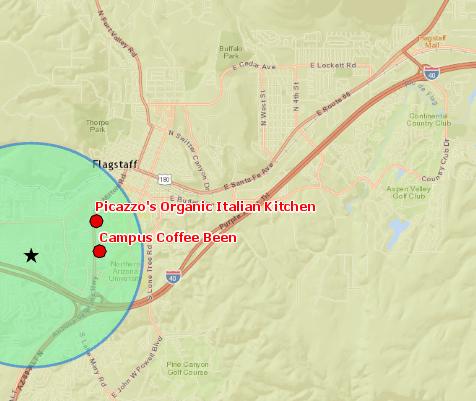
Query:
Show me restaurants within 1.5 miles that are open by 4 PM today, offer Chicago pizza, and are not large chains.
Python script:
import arcpy
import datetime
arcpy.env.workspace = "c:/apps/Restaurants/Restaurants.gdb"
# Get restaurants within 1.5 miles of location
result = arcpy.MakeFeatureLayer_management("Restaurants", "AllRestaurants")
lyrRestaurants = result[0]
dLongitude = -111.676364
dLatitude = 35.181468
sr = arcpy.SpatialReference(4326) # GCS_WGS_1984
sDist = "1.5 Miles"
sTmpWS = "in_memory"
sTmpLoc = "tmpLoc"
sTmpLocPath = sTmpWS + "/" + sTmpLoc
sTmpBuf = "tmpBuf"
sTmpBufPath = sTmpWS + "/" + sTmpBuf
arcpy.CreateFeatureclass_management(sTmpWS, sTmpLoc, "POINT", "", "DISABLED", "DISABLED", sr)
pt = arcpy.Point(dLongitude, dLatitude)
with arcpy.da.InsertCursor(sTmpLocPath, ["SHAPE@"]) as cursor:
cursor.insertRow([pt])
arcpy.Buffer_analysis(sTmpLocPath, sTmpBufPath, sDist)
result = arcpy.MakeFeatureLayer_management(sTmpBufPath, "Buffer")
lyrBuf = result[0]
arcpy.SelectLayerByLocation_management(lyrRestaurants, "INTERSECT", lyrBuf, "", "NEW_SELECTION")
sRestaurantIDs = "("
Fields = ["GLOBALID"]
with arcpy.da.SearchCursor(lyrRestaurants, Fields) as cursor:
bFirst = True
for row in cursor:
if bFirst:
bFirst = False
else:
sRestaurantIDs += ","
sRestaurantIDs += "'" + row[0] + "'"
sRestaurantIDs += ")"
arcpy.Delete_management(sTmpLoc)
arcpy.Delete_management(sTmpBuf)
# Get ids for restaurants that are open by 4 PM today
sToday = datetime.date.today().strftime("%A")
sHoursIDs = "("
Fields = ["RestaurantID"]
sWhere = "day = '" + sToday + "'"
sWhere += " AND start <= 16 AND end >= 18 AND restaurantid IN " + sRestaurantIDs
with arcpy.da.SearchCursor("Hours", Fields, sWhere) as cursor:
bFirst = True
for row in cursor:
if bFirst:
bFirst = False
else:
sHoursIDs += ","
sHoursIDs += "'" + row[0] + "'"
sHoursIDs += ")"
# Get restaurants with Chicago pizza that match criteria
sWhere = "globalid IN " + sHoursIDs
sWhere += " AND keywords LIKE '%pizza%' AND keywords LIKE '%chicago%'"
sWhere += " AND category <> 'Large'"
result = arcpy.MakeFeatureLayer_management("Restaurants", "ChicagoPizzaDinner", sWhere)
lyrRestaurants = result[0]
arcpy.SetParameter(0, lyrRestaurants)
Results:
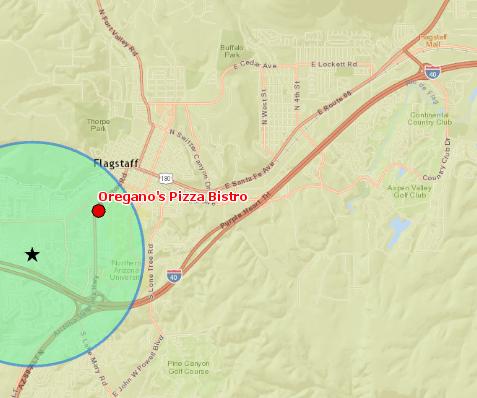
Query:
Show me the number and average of all ratings for the Crown Railroad by meal type (Breakfast, Lunch, Dinner).
Python script:
import arcpy
import datetime
arcpy.env.workspace = "c:/apps/Restaurants/Restaurants.gdb"
# Get summary stats for restaurant
ReviewSums = {"Breakfast":0, "Lunch":0, "Dinner":0};
ReviewCounts = {"Breakfast":0, "Lunch":0, "Dinner":0};
ReviewAvg = {"Breakfast":0, "Lunch":0, "Dinner":0};
MealFields = ["Breakfast", "Lunch", "Dinner"]
sWhere = "restaurantid = '{6100406A-F47B-4386-8080-745A0F977378}'"
with arcpy.da.SearchCursor("Reviews", MealFields, sWhere) as cursor:
for row in cursor:
if row[0]:
ReviewCounts["Breakfast"] += 1
ReviewSums["Breakfast"] += row[0]
if row[1]:
ReviewCounts["Lunch"] += 1
ReviewSums["Lunch"] += row[1]
if row[2]:
ReviewCounts["Dinner"] += 1
ReviewSums["Dinner"] += row[2]
for sKey in ReviewCounts.keys():
iCount = ReviewCounts[sKey]
if iCount == 0:
continue
ReviewAvg[sKey] = ReviewSums[sKey] / iCount
# Populate output table
sTableName = "CrownRailroad"
if arcpy.Exists(sTableName):
arcpy.DeleteRows_management(sTableName)
else:
arcpy.CreateTable_management("", sTableName)
arcpy.AddField_management(sTableName, "Meal", "TEXT", "", "", 20)
arcpy.AddField_management(sTableName, "Count", "LONG")
arcpy.AddField_management(sTableName, "Average", "FLOAT")
Fields = ["Meal", "Count", "Average"]
for sMeal in MealFields:
with arcpy.da.InsertCursor(sTableName, Fields) as cursor:
row = [sMeal, ReviewCounts[sMeal], ReviewAvg[sMeal]]
cursor.insertRow(row)
Results:
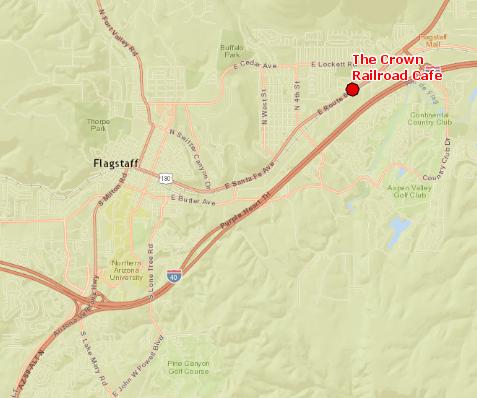
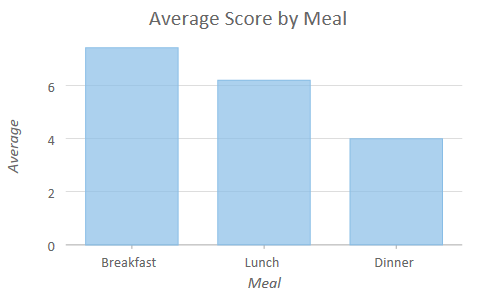
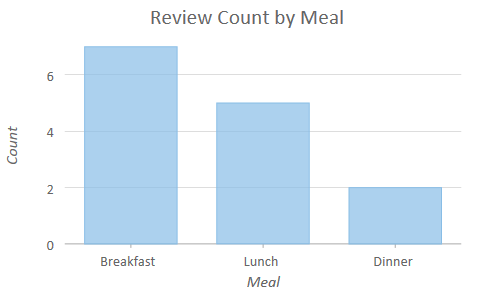
August 29, 2016